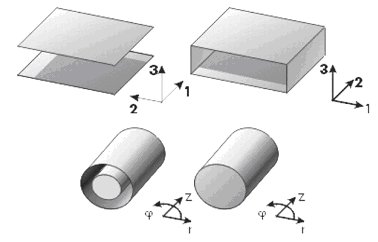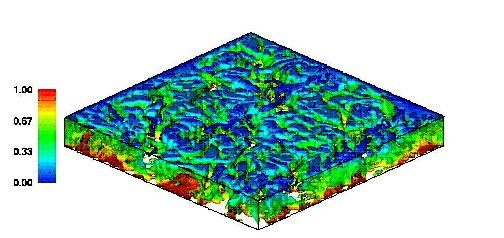DNS- and LES-Code TURBIT
Basics: TURBIT is a highly vectorized computer code for transient 3d Direct Numerical Simulation (DNS) and Large Eddy Simulation (LES) of turbulent flows in Cartesian or cylinder coordinates. It is developed in order to analyse in forced, mixed, or buoyant single phase flows the basic features of turbulence, its mechanisms and its statistics. The complete conservation equations for mass, momentum and energy are solved for incompressible Newtonian fluids of any Prandtl number. The dimensionless equations are given on the TURBIT-pages of the DNS data base.
The geometry options are plane channels with 2 or 4 walls, and annuli of any ratio of radii with 2 or 4 walls. The vector of gravity may point in any, also tilted, direction.

Plane channel and annulus options in TURBIT
Numerics: For spatial discretisation a finite volume scheme is applied. Central differences are formulated on a staggered grid resulting in a second order convection scheme. Equidistant grid spacing is used in the directions along the walls (x1-x2-plane), non-equidistant spacing in the direction perpendicular to the walls. The pressure is calculated by a projection method, so that a Poisson equation has to be solved.
For time integration a second order explicit Euler-Leapfrog scheme is applied to the momentum equation. For the energy equation the same scheme may be used, or one of the two schemes which solve the thermal diffusion implicitly: The semi-implicit Leapfrag-Crank-Nicholson scheme or the semi-implicit Adams-Bashforth-Crank-Nicholson scheme.
Physical models: For DNS no further physical models are required. For LES a subgrid scale model is available introducing a transport-equation for the subgrid scale kinetic energy. Some length scale extensions are implemented to allow for the simulation of buoyant convection with locally stably stratified fluid. By using the theory of isotropic turbulence and introducing information on the Kolmogorov and Batchelor spectra, the coefficients of the models are calculated. This makes the model widely self-adaptive from LES to DNS in going from coarse to fine grids, or from large to small Reynolds- and Peclet numbers.
Boundary conditions: The open boundaries are closed by periodic boundary conditions. The walls are impermeable. The no-slip condition is applied, and a movement or rotation of the walls in the x2-direction may be specified. In case of LES on coarse grids, wall functions may be applied, which allow also for modelling of rough walls with non-constant roughness in the x2-direction. The thermal wall conditions foresee x2-dependent heat fluxes, wall temperatures, or mixed modes, and in case of LES also Prandtl number dependent wall functions for smooth and rough walls (for 0 < Pr < 7).
Pre- and Postprocessing: Several tools are available to generate 3d initial data, e.g. by using some mean profile specifications superimposed by random numbers with specified fluctuation amplitudes and spectra, or to modify already existing simulation data to adapt them to a similar flow. Interpolation of integration results from coarser grids to finer ones is also an efficient manner of achieving new initial fields.
The postprocessing consists of many tools and interfaces to generate graphical information for cuts through the 3d data or to generate perspective isosurfaces of any quantity by means of additional software. The most important feature is the extensive analysing capability of statistical data of turbulence, up to the fourth order moments, two-point correlations and spectra, etc. and analyses of all terms of some transport equations for turbulence quantities, like for the kinetic energy, its dissipation, temperature variance, dissipation of temperature variance, and for the turbulent heat flux in the wall normal direction. Those analysing packages contain also possibilities to compare the DNS data directly to corresponding statistical models as they are used in CFD codes, e.g. in our code FLUTAN.
 |
| DNS results for the instantaneous field of the vertical velocity component (isosurface for u3=0.03) and for the temperature (colour code) in Rayleigh-Bénard Convection of Mercury or PbBi at Ra = 100 000. Rising hot fluid is enclosed within the isosurface, outside is mainly down-flowing cold fluid. Compare the much larger scales occurring in the temperature field at the same time. (Otic & Groetzbach 2003) |
Application fields: The code was the first one being developed and successfully used in Europe for LES, and it was also the first one being used in the world for DNS of a fully turbulent buoyant convection layer between rigid walls.
It was already intensively used for LES of forced convection in plane channels and annuli at different Reynolds numbers, for fluids with Prandtl numbers between 0.007 and 7, with rough and smooth walls. The main target of those simulations was verification of the code and to gain more insight into the turbulent heat transfer, into the features of eddy conductivities and their anisotropy, and into turbulent Prandtl numbers. In one example even a technical problem with strongly buoyancy influenced forced flow was successfully investigated by means of a LES on a coarse grid.
DNS for buoyant convection between horizontal fluid layers was possible since about 1979. Here, TURBIT is used to analyse the transport mechanisms in internally heated fluid layers and in Rayleigh-Bénard convection at various Prandtl numbers and to analyse the more sophisticated turbulent heat flux models basing on some transport equations, to gain the information to develop new models and to validate them. For some of the DNS results see the DNS data base.
Supplemental information: TURBIT was also the starting point for many PhD works outside FZK and outside Germany. Meanwhile, TURBIT was also used as a starting point to develop the DNS code TURBIT-VoF for the direct simulation of channel flows with interfaces, e.g. for flows in macro or micro channels containing bubbles.
The theoretical background of DNS and LES of turbulence in single-phase flows is presented in a lecture series at the University of Karlsruhe.
References to the method and the code:
- Schumann, U., Subgrid scale modeling for finite difference simulations of turbulent flows in plane channels and annuli. J. Comp. Phys. 18, pp. 376-4o4 (1975)
- Schumann, U., Linear stability of finite difference equations for three-dimensional flow problems. J. Comp. Phys. 18, pp. 465-470 (1975)
- Groetzbach, G., Direkte numerische Simulation turbulenter Geschwindigkeits-, Druck- und Temperaturfelder bei Kanalstroemungen. Dissertation, Univ. Karlsruhe, KfK 2426, Kernforschungszentrum Karlsruhe (1977). English translation in DOE-tr-61 (USDOE 1978)
- Schumann, U., Groetzbach, G., and Kleiser, L., Direct numerical simulation of turbulence. Prediction Methods for Turbulent Flows, ed. Kollmann, W., Hemisphere, New York, pp. 123-258 (1980)
- Groetzbach, G., Direct numerical and large eddy simulation of turbulent channel flows. Encyclopaedia of Fluid Mechanics, ed. N. P. Cheremisinoff, Gulf Publishing, Houston, Texas, vol. 6, pp. 1337-1391 (1987)
- Woerner, M., Groetzbach, G., Analysis of semi-implicit time integration schemes for direct numerical simulation of turbulent convection in liquid metals. Notes on Numerical Fluid Mechanics, Vol. 35, pp. 542-551, Verlag Vieweg, Braunschweig (1992)
- Woerner, M., Direkte Simulation turbulenter Rayleigh-Benard Konvektion in fluessigem Natrium. Dissertation, Univ. Karlsruhe, KfK 5228, Kernforschungszentrum Karlsruhe (1994)
- Seiter, C., Numerische Simulation turbulenter Auftriebsstroemungen in horizontalen Kanaelen. Dissertation, Univ. Karlsruhe, FZKA 5505, Forschungszentrum Karlsruhe (1995)
- Grötzbach,G., Revisiting the Resolution Requirements for Turbulence Simulations in Nuclear Heat Transfer. Nuclear Engineering & Design, Vol. 241, 2011, pp. 4379-4390 DOI: 10.1016/j.nucengdes.2010.12.027
- Grötzbach, G., Challenges in low-Prandtl number heat transfer simulation and modeling. Nuclear Engineering & Design, Vol. 264, 2013, pp. 41-55, Doi: 10.1016/j.nucengdes.2012.09.039
References to some forced and mixed convection applications:
- Schumann, U., Numerical investigation of the wall pressure fluctuations in channel flows. Nucl. Eng. & Design 32, p. 37-46 (1975)
- Groetzbach, G., Direct numerical simulation of secondary currents in turbulent channel flows, Lect. Notes in Phys. 76, pp. 308-319, Springer Verlag (1978)
- Groetzbach, G., Schumann, U., Direct numerical simulation of turbulent velocity-, pressure- and temperature-fields in channel flows. Turbulent Shear Flows I, ed. Durst, F. et al., pp. 37o-385, Springer Verlag (1979)
- Groetzbach, G., Numerical investigation of radial mixing capabilities in strongly buoyancy-influenced vertical turbulent channel flows. Nucl. Eng. & Design 54, pp. 49-66 (1979)
- Groetzbach, G., Numerical simulation of turbulent temperature fluctuations in liquid metals, Int. J. Heat & Mass Transfer 24, pp. 475-490 (1981)
References to some applications for convection in internally heated fluid layers:
- Groetzbach, G., Spatial resolution requirements for numerical simulation of internally heated fluid layers, Numerical Methods in Laminar and Turbulent Flow, ed. Taylor, C., Schrefler, B. A., pp. 593-6o4, Pineridge Press ltd. (1981)
- Groetzbach, G., Direct numerical simulation of the turbulent momentum and heat transfer in an internally heated fluid layer. Heat Transfer 1982, ed. Grigull, U. et al., Hemisphere Publ. Corp. Washington, Vol. 2, pp. 141-146 (1982)
- Groetzbach, G., Turbulent heat transfer in an internally heated fluid layer. Refined Flow Modelling and Turbulence Measurements, Ed. Y. Iwasa, et al., Universal Academy Press Inc., Tokyo, pp. 267-275 (1989)
- Woerner, M., Schmidt, M., Groetzbach, G., DNS of turbulence in an internally heated convective fluid layer and implications for statistical modelling. Journal of Hydraulics Research 35, pp. 773-797 (1997)
- Chandra, L., A model for the turbulent diffusion of turbulent kinetic energy in natural convection. Dissertation, Univ. Karlsruhe, FZKA 7158, Forschungszentrum Karlsruhe (2005)
- Chandra, L., Grötzbach, G., Analysis and modelling of the turbulent diffusion of turbulent heat fluxes in natural convection. Int. J. Heat & Fluid Flow 29, pp. 743-751 (2008) DOI:10.1016/j.ijheatfluidflow.2008.01.009
References to some applications for Rayleigh-Bénard convection in various fluids:
- Groetzbach, G., Direct numerical simulation of laminar and turbulent Bénard convection. J. Fluid Mech. 119, pp. 27-53 (1982)
- Groetzbach, G., Spatial resolution requirements for direct numerical simulation of the Rayleigh-Bénard convection. J. Comp. Physics 49, pp. 241-264 (1983)
- Groetzbach, G., Woerner, M., Inertial convection in turbulent Rayleigh-Bénard convection at small Prandtl numbers. Computational Fluid Dynamics, Selected Topics, Eds. D. Leutloff, R. C. Srivastava, Springer Verlag Berlin, pp. 219 – 232 (1995)
- Bunk, M., Woerner, M., Direkte numerische Simulation turbulenter Rayleigh-Bénard-Konvektion in Quecksilber. FZKA 5915, Forschungszentrum Karlsruhe (1998).
- Woerner, M., Ye, Q.-Y., Groetzbach, G., Consistent modelling of fluctuating temperature-gradient-velocity-gradient correlations for natural convection. Engineering Turbulence Modelling and Experiments 4, Eds.: W. Rodi, D. Laurence, Elsevier Science B. V., pp. 165-174 (1999)
- Otic, I., Groetzbach, G., Direct numerical simulation and RANS modeling of turbulent natural convection for low Prandtl-number fluids. Computational Technology for Fluid / Thermal / Chemical / Stressed Systems with Industrial Applications, Eds. V. Kudriavtsev, et al., ASME, PVP-Vol. 491-2 (2004) pp. 159-165, ISBN 0-7918-4686-5
- Otic, I., Grötzbach, G., Wörner, M., Analysis and modelling of the temperature variance equation in turbulent natural convection for low Prandtl number fluids. J. Fluid Mech. 525, pp. 237-261 (2005)
For further references on the TURBIT code and its applications consider the databank of FZK publications and search for the publications of the authors listed above.
Contact person:
G. Groetzbach, e-mail: groetzbach at partner.kit.edu
